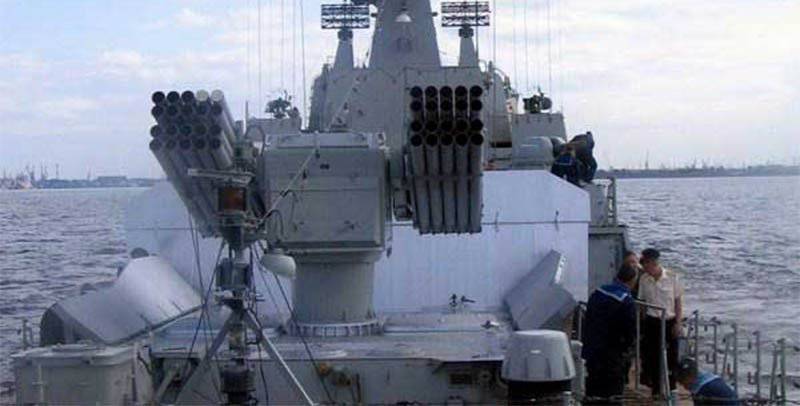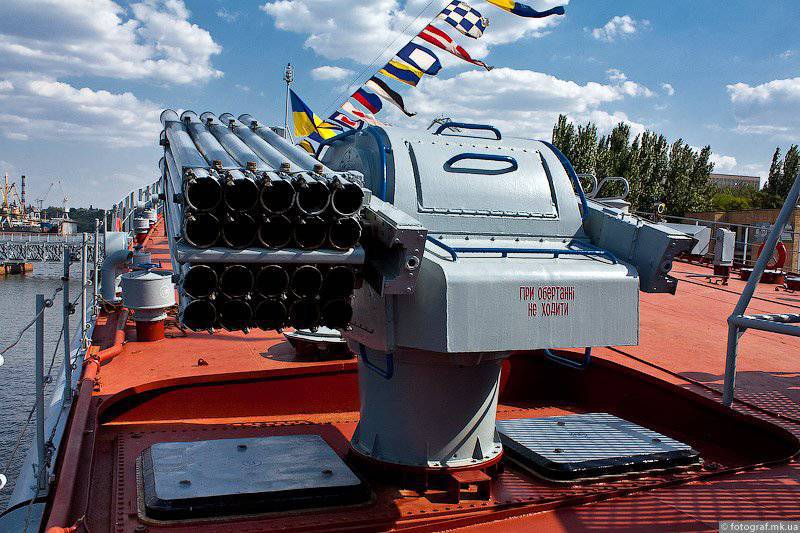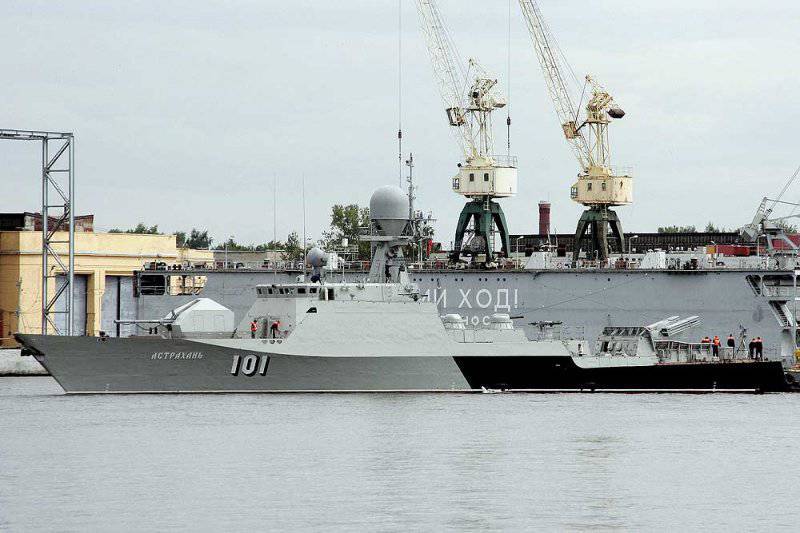Ship 122 millimeter volley fire system A-215 Grad-M
TTZ for the development of the 122-mm naval MLRS A-215 based on the multiple launch rocket system 9K51 Grad was approved by the Deputy Commander-in-Chief of the Naval fleet 12.01. 1966. The first prototype of PU was manufactured at plant No. 172 in mid-1969. In the third and fourth quarters of 1969, it passed factory tests in Perm, and then it was sent to field tests. In the first quarter of 1970, the plant delivered a second copy of the installation. The charging device and the underdeck parts of the installation were manufactured by the Barricades factory.

The A-215 ship tests were carried out from March 20 to 7 1972 in the Baltic Sea on a large landing ship BDK-104 Ave 1171 (serial number 300). During the tests, X-NUMX shots were fired with M-300OF army shells, the sea was up to 21 points. There were no failures and delays at the same time, except for the unreliable operation of the contacts of the presence in the guides of the PU shells.
Complex A-215 according to the results of ship tests was recommended for the commissioning of ships of the 1171 ave. (Factory numbers 295 – 301) and so on 1174 (1 launcher and ammunition from 320 missiles). Later, the Central Research Institute of Automation and Hydraulics MOP and the Leningrad Optical-Mechanical Association developed an autonomous indirect stabilization scheme. In 1977, on the basis of it created a new rangefinder target device TLD-2. The A-215 system equipped with a TLD-2 was adopted in 1978.
The upgraded A-215 “Grad-M” rocket launcher system is part of the weapons of the small artillery ships of the “Buyan” series of the 21630 project. The lead ship of this project, the Astrakhan (serial number 701), was laid down at the Almaz shipyard (St. Petersburg) 30 in January 2004. The ship was launched into 07.10.2005, and was commissioned in 2006. At the Almaz shipyard before 2010, it was planned to build 7 ships of this series (according to other data, up to 2015, 10 ships).
Two A-215 (total 320 ammunition for missiles) are installed on the new large landing ship of the 11711 project (developed by the Nevsky PKB). The lead ship of the series, Vice Admiral Ivan Gren, laid the foundation for 2004 in December at the Yantar Baltic Shipbuilding Plant in Kaliningrad, the commissioning of the fleet at the beginning of 2009.
The A-215 Grad-M volley fire complex consists of:
deck launcher MC-73 (MC-73M) with a deck-mounted charging device,
laser distance measuring sight device TLD-2,
fire control systems PS-73 “Thunderstorm”,
122-mm unguided rockets (NURS).
The main type of ammunition is a high-explosive fragmentation projectile 9М22У, which provides the system with a target range of up to 20 thousand meters. Ammunition consists of 160 shells.
For stabilization in the conditions of rolling and remote targeting, the MC-73 launcher is equipped with tracking drives. The drum below-deck charger holds eight launch packs each of which consists of 20 unguided rockets. Packages when loading in pairs served on the vertical guides of the launcher. Empty bags after the volley are lowered into the drum, the next pair is installed on the guides. It takes less than 50 seconds to load the launcher. The reload time is 2 minutes.
The fire in the automatic mode using the data of the fire control system is conducted alone or in one gulp. With salvo fire, the interval between launches is 0,5 seconds. The launcher makes it possible to carry out deep modernization in terms of the use of calibers and types of ammunition, including the use of short-range air defense missiles. It is possible to integrate the launcher into a single rocket and artillery vehicle complex. There is the option of placing the PU without a charging device. In this case, the ammunition is designed for one salvo, and reloading is carried out manually.

For the complex developed system PUS (fire control devices) PS-73 "Thunderstorm". The CCP provides indication of the presence in guide shells; automatic reception of the current value of the coordinates of the target; automated and continuous development of full PU guidance angles; issuing commands to launch shells.
The advanced complex A-215М was created on the basis of PU MC-73 and an optical-electronic control system SP-520М-2. In addition to the standard 9М22У rockets, the complex included missiles with an increased 9М521 range, which provide high-explosive and fragmentation targets at a range of up to 40 thousand meters. The fire control system is coupled to the ship’s radar equipment and ensures high accuracy and speed of data generation for firing , including unobservable targets. To increase the effectiveness of destroying targets with splinters, it is supposed to use a 9М522 missile with a detachable high-explosive fragmentation warhead. Due to the vertical approach of the warhead to the target, the effectiveness of the fragmentation of this warhead increases 6 times as compared with the 9М22У projectile.
Tactical and technical characteristics of the ship 122-mm A-215 Grad-M salvo fire:
Caliber - 122 mm;
The number of stems - 40;
Maximum firing range - 20700 m;
The minimum table shooting range is about 2000 m;
Vertical guidance angle - from -6 to + 93 degrees;
The angle of horizontal guidance is ± 164 degrees;
Vertical guidance speed - 26,4 degrees / s;
Horizontal guidance speed - 29 degrees / s;
The mass of installation with devices of giving and storage - 16500 kg;
The mass of the complex without spare parts and projectiles - 20727 kg;
The mass of the complex with spare parts and projectiles is about 31000 kg;
Cellar length - 4,5 m;
Length width - 4 m;
Length height - 3,8 m;
The width of the launcher without packages in the stowed position - mm 1710;
The height of the launcher without packages in the stowed position - mm 2100;
Sweeping radius - mm 1500;
Calculation - 2 people;
The interval between the launches of shells in a volley - 0,5 with;
Loading time from the production of the first shot - 46 with;
Recharge time - 120 with;
Execution time of all ammunition - 7,3 min.

Information